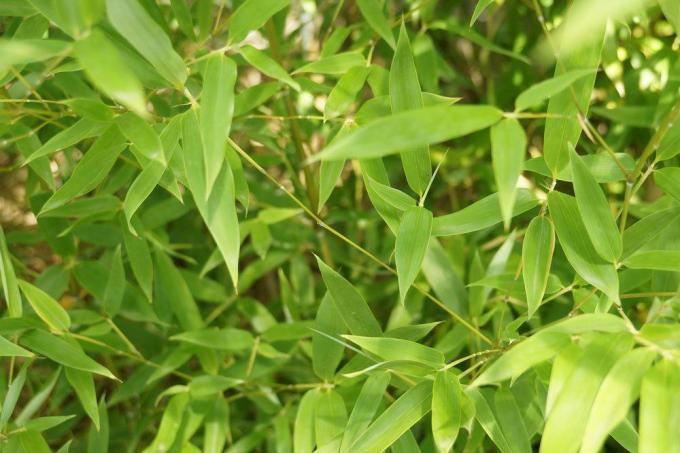
table of contents
- Regular pruning
- Types of cuts
- Young plants
- time
- First correction cut
- Main cut
- Bamboo in the bucket
- Special case: ground cover species
- Cutting after frost damage
The fact that the garden bamboo can grow very lush is only one reason to prune it regularly. In general, the appearance of Fargesia murielae can be enhanced in this way. However, the prerequisite for optimal growth after the pruning is that the timing is right. But when did it come?
Regular pruning
Fargesia murielae is known for coping well with radical prunings. Reaching for secateurs every now and then even makes sense to do the following:
- produce a denser, more compact growth
- give the garden bamboo an attractive shape
- curb growth
- remove bare branches
- remove diseased branches
- provide more light
- rejuvenate the bamboo

Types of cuts
In contrast to numerous other shrubs, the bamboo is not only radically shortened once. Over time, cuts of different strengths are recommended at different times. There are three types of cuts:
- the care cut
- the cut back
- the topiary
Care cut
The maintenance pruning is usually carried out twice a year and is primarily carried out on bamboo hedges. On the one hand, it serves the Shape retentionby removing protruding branches and bare twigs. On the other hand, the better light supply through the thinning ensures a denser and bushier growth. To do this, the side shoots are also shortened.
Cut back
The garden bamboo demands one every four to five years rejuvenationby cutting it back radically to 20 cm above the ground. Anyone who is afraid of trimming their shrub too much in this way will be amazed at how quickly it recovers from pruning. After a short time, the bamboo rewards the effort with an intense, dense growth.
Topiary
The topiary plays an important role, especially when it comes to keeping bonsai. Fargesia murielae is a very fast-growing plant, which is why a shaping cut is regularly necessary to maintain the appearance. Fortunately, the plant allows the gardener to let off steam artistically according to his mood.
Young plants
In the first few years, however, you should refrain from any form of cutting, as the leaves must first develop completely. This is important so that the bamboo can photosynthesize. In the process, it converts oxygen, light and water into sugar and glucose, substances from which it draws energy for its growth.

time
So that the grass recovers well from cutting, the right time is of great relevance. Although the different cuts are sometimes done more often, sometimes less often, they should always be done at the same time of year.
First correction cut
A garden bamboo sprouts in spring. In order not to damage the new leafy green, the first corrective cut must be made beforehand. in the March is the ideal time to cut the grass. Initially, only the protruding side shoots are shortened.
Main cut
Since bamboo grows rapidly, an annual correction cut is not enough to keep its shape. A radical cut back is essential at a later point in time. In order to save as much work as possible, you should start this after the leaves have sprout. The development of the side branches serves as a reliable indicator that it is time for the main cut. The date of the procedure also depends on the climatic conditions. In colder areas it should happen a little later, namely after the Ice Saints. It is possible earlier in warmer regions.
Although the main cut shortens the plant considerably, it soon sprouts again and reaches the usual height in a short time. In order to create the desired shape, the radical pruning is followed about a month and a half later by a shaping cut in which the new shoots are adapted to the original growth shape. Here, too, the temperature is decisive. If the bamboo is only cut in May, the second cut can still be made in June.
Bamboo in the bucket
The natural growth form of the garden bamboo rises upwards. Nevertheless, the grass is gaining increasing popularity as a bonsai culture or container plant. In contrast to the use as a hedge plant, several shape cuts are then required over the whole year. Not only leaves but also roots have to be shortened. The latter is recommended when repotting.
Special case: ground cover species
Some types of bamboo are used as Ground cover in the garden. However, under the local weather conditions they sprout later than the common Fargesia murielae. Accordingly, the cut also shifts backwards.
Cutting after frost damage
At temperatures of -20 ° C, frost damage can occur, which manifests itself in brown leaves and twigs. Most of the time, the symptoms become apparent in February. Nevertheless, despite the bleak appearance, the gardener should not immediately reach for scissors, but should wait for the regular pruning date in June. The plant may recover on its own. Only when no new roots have formed in summer does a radical cut help to new shoots.
tip: The garden bamboo is so popular because there is no risk of defacing it with too radical pruning. Even after intensive shortening of the shoots, they sprout again after a short time and close unaesthetic holes. This enables the gardener to let his imagination run wild and to try out different artistic forms. Thanks to this property, the grass is also ideal for bonsai keeping. However, there are different types of bamboo that have a different character Growth rate exhibit. Accordingly, the gardener should adjust the intensity and frequency of pruning for each variety.

